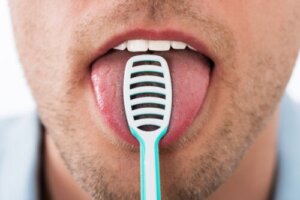Cleaning Your Tongue Properly: Tips and Tricks


Written and verified by the dentist Vanesa Evangelina Buffa
Taking care of teeth hygiene is something most of us have pretty much built in. But cleaning your tongue properly should also be part of this routine and not everyone knows how to do it.
Forgetting the tongue during oral cleaning is quite common. And, as we’ll show you in this article, neglecting this organ brings problems in health and the correct functioning of the mouth.
Knowing the importance of cleaning your tongue and knowing how to do it correctly will help you not to forget this aspect of oral hygiene. You’ll see that it’s quite simple and will bring you many benefits. Keep reading and we’ll tell you all about it.
The importance of cleaning your tongue correctly
The tongue is a mobile organ, anchored to the base of the mouth and composed of several muscle groups covered with mucous tissue. It plays a fundamental role in the oral cavity. It’s involved in chewing, bolus formation, swallowing, oral hydration, speech, and the sense of taste.
The tongue has nerve endings and a great irrigation, which causes it to hurt and bleed a lot if it’s injured. Its normal appearance is pink, moist and mobile.
In addition, its dorsum is covered with papillae that give its surface a characteristic velvety appearance. Some of these structures are involved in taste perception. Others are capable of touch, have lymphatic functions, or produce saliva.
Cleaning the tongue properly is important in order to keep this organ healthy and its functions running normally. Otherwise, bacteria in the mouth would proliferate and food debris would accumulate on its surface.
A tongue without proper hygiene predisposes to the appearance of several problems:
- Halitosis or bad breath
- Alterations in the sense of taste
- Changes in the normal flora of the mouth, with the development of mycosis
- Its appearance is altered by the accumulation of dirt. The tongue looks white or black and its surface becomes smoother.
- It favors the establishment of pathogenic bacteria that cause caries, gingivitis, periodontal disease and other infections.
Taking a few minutes a day to clean your tongue will prevent these problems. A well cared for tongue will be able to continue to fulfill its functions.
In addition, you won’t experience bad breath, taste alterations, or problems chewing, swallowing, or speaking. Therefore, it is worth the time you spend cleaning it. Keep reading and we’ll tell you how to do it.
Find out more here: Your Tongue Can Reveal The State of Your Emotions and Health
How to clean your tongue properly?
Cleaning your tongue properly every day will allow you to keep this organ healthy. Here are some tips and tricks to consider when cleaning this part of your mouth.
1. Incorporate tongue hygiene into your toothbrushing routine
The first thing you should do to clean your tongue properly is to incorporate tongue hygiene into your dental hygiene routine. If you make it part of your tooth brushing routine, there is less chance of forgetting or putting off cleaning it.
Every day, after meals, you should brush your teeth and gums for at least 2 minutes. To do this, you’ll use a soft bristle brush and a toothpaste containing fluoride.
In addition, you should complete the hygiene by using dental floss. This removes germs and food debris that accumulate between the teeth and that brushing cannot reach.
Ensuring proper hygiene of the teeth prevents residues and bacteria that could later be deposited on the tongue. Starting with the hygiene of the teeth is the first step before moving on to cleaning the tongue.

2. Cleaning the tongue
To clean the tongue properly, a tongue scraper or tongue cleaner is ideal. This is a tool designed to remove bacteria and debris from the surface of the organ.
But if you don’t have a tongue scraper, you can still clean your tongue. Using the bristles of the brush or the back of the brush can make up for the lack of a scraper and help you.
To clean the tongue, gentle scraping movements should be made from the furthest back area forward, until you reach the tip. The process should be repeated several times and the sides of the organ should also be cleaned. With every forward movement, it’s advisable to rinse the mouth with water to remove loose debris.
Some people often have problems with cleaning their tongue because of the gag reflex generated by placing the scraper so far back. A deep breath before starting helps. Also, as the body gets used to the habit, the discomfort will diminish.
As mentioned, the tongue scraper is the best instrument to clean the tongue properly. However, if you don’t have one, there are other ways to ensure the hygiene of this part of the mouth.
The tongue scraper, or cleaner
This is a small, serrated instrument designed to clean the tongue properly. It consists of a curved, U-shaped or Y-shaped bar that scrapes the tongue surface. They’re available in different sizes and materials.
It’s very simple to use. As the name suggests, the tongue should be scraped gently.
To do this, movements are made from back to front, that is, from the deepest part of the tongue to the tip. The angulation should be varied to reach all areas of the organ.
This action is repeated several times to ensure that the entire tongue is cleaned. With each pass, the scraper removes bacteria, food debris and dead cells trapped in the irregularities of the tongue dorsum.
After each forward movement, it’s a good idea to rinse the scraper and your mouth with water. When finished, the cleaner should be washed to keep it hygienic and in good condition until its next use.
Tongue brushes
Tongue brushes are also instruments created especially for tongue cleaning. They differ from scrapers in that they have several bristles that act like a brush or broom.
When you run it over the tongue, it removes debris and bacteria build-up. The sensation it causes in the person is less intense than that of the scraper, so it’s more suitable for people with high sensitivity in their tongues.
Classic toothbrush
The toothbrush is an instrument designed to clean dental surfaces, which are hard. Therefore, it isn’t the best tool for sanitizing the tongue, which is a soft organ.
In fact, when researchers compared them to tongue scrapers, they found that they aren’t as effective as the latter in removing debris accumulated on the tongue dorsum.
If there’s no other alternative for cleaning the tongue, a traditional toothbrush can be used. It’s preferable to do it with this less effective instrument than not cleaning at all.
A soft bristle toothbrush should be chosen and it should be reserved exclusively for cleaning the tongue. Therefore, it will be a different brush than the one used for the teeth.
A toothbrush with a tongue cleaner incorporated in the brush head
Some modern toothbrushes have a scraped surface on the back of the brush head for cleaning the tongue. But the efficiency of this accessory is rather limited.
The toothbrush head with tongue cleaner is useful only for tongue tip hygiene. If the tip instrument is placed in the back area of the mouth, it usually causes a lot of gagging.
3. Use mouthwash
To finish the process of cleaning the tongue properly, it’s advisable to use a mouthwash. Rinse vigorously for a few minutes with these liquids to remove any residue left on the tongue.
Remember to spit out the product when you finish, as they aren’t designed for swallowing.
Mouthwashes contain different components that help protect the mouth against bacterial plaque and provide fresh breath. There are those with fluoride, antiseptics or natural ingredients, capable of keeping germs under control. Your dentist will be able to tell you which one is right for you.

4. Clean your tongue correctly on a frequent basis
To clean the tongue correctly, it isn’t only necessary to do it well, but it’s also important to make it a frequent habit. As we said, incorporating tongue hygiene into your toothbrushing routine will allow you to do it several times, every day.
It’s important to clean the tongue at least twice a day. It’s very important to do it before going to bed, because during the night we secrete less saliva. In this way, we can go through the night with a clean mouth and have more control of harmful bacteria.
This prevents the accumulation of bacteria, the formation of whitish plaque and bad breath. Experiencing the comfort of having a clean tongue is usually enough motivation to continue taking care of this area.
Find out more: What Are Black Spots on the Tongue?
How to know if the tongue is clean?
At the end of the oral cleaning routine, it’s advisable to stick out your tongue in front of a mirror and observe it. Observing its surface allows you to check that the hygiene has been carried out properly.
After cleaning the tongue properly, its surface appears pink. On the other hand, if white or yellowish areas are observed, it’s because it hasn’t been completely sanitized.
Most of the time, when the tongue looks whitish, it’s due to the presence of bacteria accumulated on its surface. But other times it may be the manifestation of oral conditions, such as oral candidiasis, lichen or leukoplakia, for example.
If, after repeated brushing, the tongue regains its usual pink color, there’s no reason to worry. However, if the whitish color persists, it’s necessary to consult a dentist to evaluate the situation.
When to see a dentist?
For the tongue to function normally, it’s important to take care of its hygiene. But it’s also necessary to take proper care of it by visiting the dentist regularly.
During routine visits, the dentist observes the appearance of the tongue and evaluates its mobility. In this way, they’ll be able to diagnose any condition that may arise early.
It’s also important to pay attention to the appearance of the tongue. As we said, observing this organ when you finish cleaning it allows you to detect any unusual changes.
It’s important to visit the dentist or doctor if any of these manifestations appear on the tongue:
- Pain
- Severe burns
- Red patches or spots
- Smoother areas of the tongue
- Hairy tongue appearance
- Wounds that don’t heal after a few days
- A surface with a yellow or black discoloration
- White spots that don’t disappear with cleaning
- Sores or bumps that don’t disappear after a few weeks
A clean and healthy tongue
Cleaning the tongue correctly is quite simple and worthwhile. Having a healthy tongue is essential for regular tasks, such as eating, talking, and tasting.
It may take some time to get into the habit of including your tongue in your oral hygiene. When you notice how good it feels to have this part of your mouth clean and fresh, you certainly won’t forget to do it.
All cited sources were thoroughly reviewed by our team to ensure their quality, reliability, currency, and validity. The bibliography of this article was considered reliable and of academic or scientific accuracy.
- Barba, L., & Valerio, I. (2020). Halitosis: Principios básicos sobre su origen y tratamiento Revisión narrativa. Odovtos International Journal of Dental Sciences, 22(1), 47-59.
- Singh, S., Singh, D., & Macedo, M. B. L. (2022). Dispositivos para remoção da saburra lingual: revisão de literatura. Research, Society and Development, 11(6), e54411629554-e54411629554.
- Gallego, A. P. (2022). La patología lingual. FMC-Formación Médica Continuada en Atención Primaria, 29(5), 256-260.
- Félix Corrales, C. A. (2018). Relación entre la remoción del cubrimiento lingual y los niveles de compuestos volátiles sulfurados utilizando un limpiador lingual vs un cepillo dental.
- Pedrazzi, V., Sato, S., de Mattos, M. D. G. C., Lara, E. H. G., & Panzeri, H. (2004). Tongue‐cleaning methods: a comparative clinical trial employing a toothbrush and a tongue scraper. Journal of periodontology, 75(7), 1009-1012.
- Jiménez, A. I. V., & Bolaños, F. J. (2016). Lengua vellosa negra. Reporte de caso clínico. Odovtos-International Journal of Dental Sciences, 18(1), 29-33.
- Villalobos, O. J., Salazar, C. R., & Ramírez de Sánchez, G. (2001). Efecto de un enjuague bucal compuesto de aloe vera en la placa bacteriana e inflamación gingival. Acta odontológica venezolana, 39(2), 16-24.
- Van Tornout, M., Laleman, I., Dadamio, J., Degeest, S., Vancauwenberghe, F., & Quirynen, M. (2014). Halitosis y cubrimiento lingual. Periodoncia y osteointegración, 24(1), 17-21.
- Danser, M. M., Gómez, S. M., & Van der Weijden, G. A. (2003). Tongue coating and tongue brushing: a literature review. International journal of dental hygiene, 1(3), 151-158.
This text is provided for informational purposes only and does not replace consultation with a professional. If in doubt, consult your specialist.








